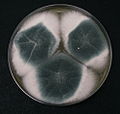Aspergillus
The genus Aspergillus is classified as a fungi. Aspergils are among the most common fungi in the environment. About 150 species of these fungi are currently described[1], but only about twenty of them have been shown to cause disease in humans. They endanger humans in two ways: intoxication and infection. Like many other micromycetes, aspergillus is a major cause of nosocomial infections and their danger is growing.
Microbiological culture[edit | edit source]
The genus Aspergillus includes predominantly fast-growing micromycetes. They grow well on different agars in 2-4 days.[1] Colonies excel at a variety of pigments that can diffuse far into the agar.
Morphology[edit | edit source]
They are fibrous fungi, where the individual fibers (hyphae) are divided by septa. Macroscopically, in aspergillus we find formations called mycelium, which have two parts: vegetative mycelium, which grows into the soil from which it draws nutrients, and aerial mycelium, whose fibers' terminal parts extend into conidiophores that carry conidia (spores), its reproductive elements. The most important fungi belonging to the genus Aspergillus include A. fumigatus, the most common cause of aspergillosis, A. flavus, that produces mycotoxin and the carcinogen aflatoxin (for example in cereals and peanuts), A. niger, A. terreus, A. carbonarius, A. ochraceus and A. parasiticus.
Pathogenicity and epidemiology[edit | edit source]
Of all the fungi that cause disease in humans, none are as widespread in nature as the genus Aspergillus. Aspergillus species are ubiquitous, occurring in the air, soil, dust, building materials, some foods, and water. The main point of entry for Aspergillus species is the respiratory tract. After inhalation, conidiospores mature in the lungs and can penetrate other tissues, including blood vessels or the CNS, if they are not controlled by the body's defense mechanisms.
However, most people are naturally immune to the development of the disease because alveolar macrophages have the ability to absorb and destroy conidia. This ability is reduced, in patients treated with corticosteroids and in immunodeficient patients (patients with leukemia, AIDS, chronic obstructive pulmonary disease, patients after chemotherapy or transplantation, etc.).
Diagnostics[edit | edit source]
Fungi can be detected directly in sputum, bronchoalveolar lavage (BAL) or by biopsy. Serological testing is important for diagnosis.
References[edit | edit source]
Related Articles[edit | edit source]
Literature[edit | edit source]
- VOTAVA, Miroslav, et al. Lékařská mikrobiologie speciální. 1. vydání. Brno : Neptun, 2003. 495 s. ISBN 80-902896-6-5.
- BEDNÁŘ, Marek, Andrej SOUČEK a Věra FRAŇKOVÁ, et al. Lékařská mikrobiologie : Bakteriologie, virologie, parazitologie. 1. vydání. Praha : Marvil, 1996. 558 s. ISBN 8023802976.
- GOERING, Richard V a Hazel M DOCKRELL. Mimsova lékařská mikrobiologie. 5. vydání. Praha : Triton, 2016. 568 s. ISBN 978-80-7387-928-0.





